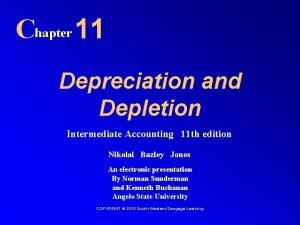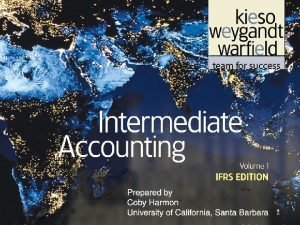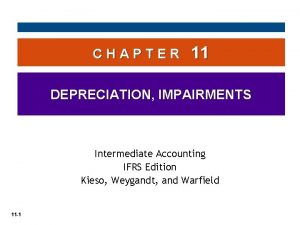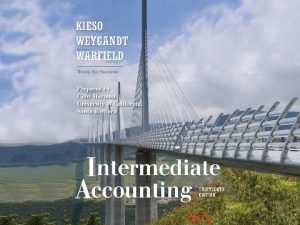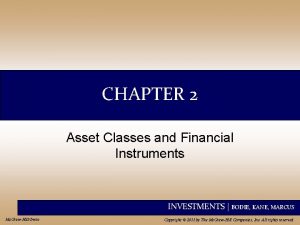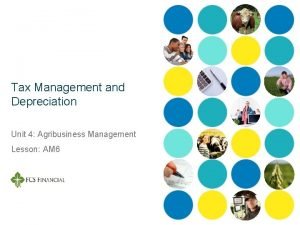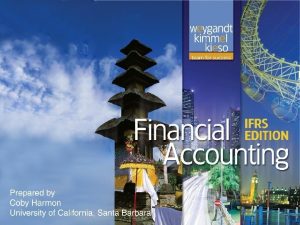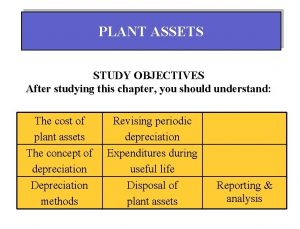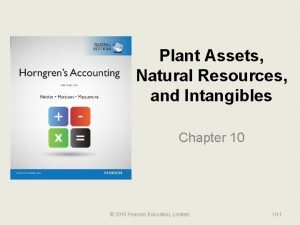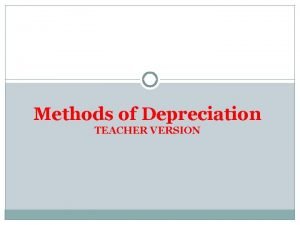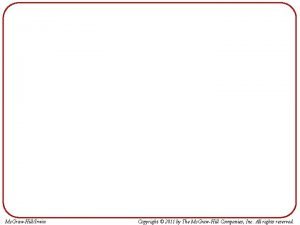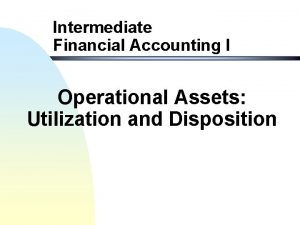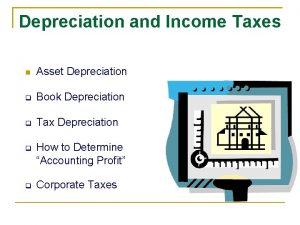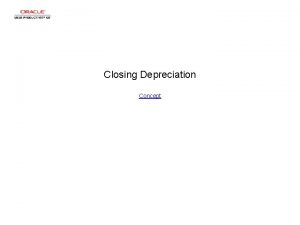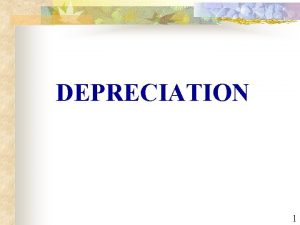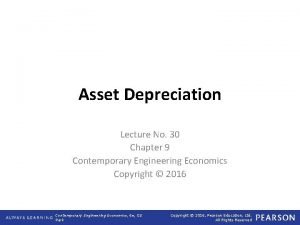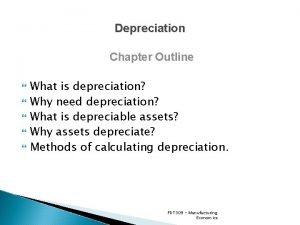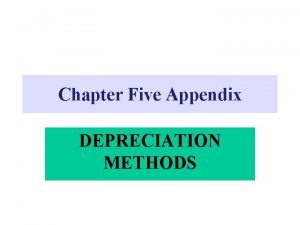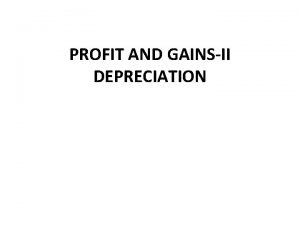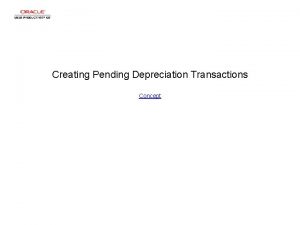Asset Depreciation Lecture No 30 Chapter 9 Contemporary













- Slides: 13

Asset Depreciation Lecture No. 30 Chapter 9 Contemporary Engineering Economics Copyright © 2010 Contemporary Engineering Economics, 5 th edition, © 2010

Depreciation Changes in Market Value End of Year 0 1 2 3 4 5 Market Value $25, 000 19, 000 16, 000 14, 000 12, 000 10, 000 Contemporary Engineering Economics, 5 th edition, © 2010 Loss of Value $6, 000 3, 000 2, 000 Depreciation q Definition: Loss of value for a fixed asset q Example: You purchased a vehicle worth $25, 000 at the beginning of year 2010.

Classification of Types of Depreciation q. Economic Depreciation: (financial position) Economic depreciation = Purchase price – market value q. Accounting Depreciation: Based on matching concept – a fraction of the cost of the asset is chargeable as an expense in each of the accounting period Contemporary Engineering Economics, 5 th edition, © 2010

Why Do We Consider Depreciation? Business Expense: Depreciation is viewed as a part of business expenses that reduce taxable income. Gross Income -Expenses: (Cost of goods sold) (Depreciation) (operating expenses) Taxable Income - Income taxes Net income (profit) Contemporary Engineering Economics, 5 th edition, © 2010

Factors to Consider in Asset Depreciation (preliminary determinations for depreciating an asset) q Depreciable life (how long? ) q Salvage value (disposal value) q Cost basis (depreciation basis) q Method of depreciation (how? ) Contemporary Engineering Economics, 5 th edition, © 2010

What Can Be Depreciated? ü Assets used in business or held for production of income ü Assets having a definite useful life and a life longer than one year (you can never depreciate land) ü Assets that must wear out, become obsolete or lose value A qualifying asset for depreciation must satisfy all of the three conditions above. Ex: buildings, machinery, equipment, vehicles etc. Contemporary Engineering Economics, 5 th edition, © 2010

Cost Basis q. Without Trade-In Allowance Cost basis of an asset represents the total cost that is claimed as an expense over the asset’s life. It includes actual cost of the asset and all other incidental expenses like freight, site preperation, and installation. Contemporary Engineering Economics, 5 th edition, © 2010

q. With Trade-In Allowance (if an asst is purchased by trading a similar asset) Trade in allowance: a reduction in the price of a new item when an old item is given as part of the deal. Consider book value – trade in allowance Contemporary Engineering Economics, 4 th edition, © 2007

Useful Life and Salvage Value q Useful life – how many years will an asset be useful to a company? q. Service life of an asset – determining is difficult, uncertainty in estimates q. Disputes between taxpayers and Internal Revenue Service (IRS) q. Adopt the Asset Depreciation Ranges (ADR) published by the Internal Revenue Service (IRS). q Salvage value – Asset’s estimated value at the end of its useful life. Every effort should be made to estimate a reasonable residual value of the asset, but if not possible, a 10% rule (10% of the initial value) could be adopted for depreciation purpose. Contemporary Engineering Economics, 5 th edition, © 2010

Contemporary Engineering Economics, 4 th edition, © 2007

Types of Depreciation Most firms calculate depreciation in 2 ways depending on whether the calculation is intended for financial reports or IRS n Book Depreciation q q n In reporting net income to investors/stockholders (balance sheet and income statement) In pricing decision Tax Depreciation q q In calculating income taxes for the IRS In engineering economics, we use depreciation in the context of tax depreciation Contemporary Engineering Economics, 5 th edition, © 2010

Summary n n n The entire cost of replacing a machine cannot be properly charged to any one year’s production; rather, the cost should be spread (or capitalized) over the years in which the machine is in service. The cost charged to operations during a particular year is called depreciation. From an engineering economics point of view, our primary concern is with accounting depreciation; The systematic allocation of an asset’s value over its depreciable life. Contemporary Engineering Economics, 5 th edition, © 2010

n q Accounting depreciation can be broken into two categories: 1. Book depreciation—the method of depreciation used for financial reports and pricing products; 2. Tax depreciation—the method of depreciation used for calculating taxable income and income taxes; it is governed by tax legislation. The four components of information required to calculate depreciation are: (a) cost basis, (b) salvage value, (c) depreciable life , and (4) depreciation method. Contemporary Engineering Economics, 5 th edition, © 2010
 01:640:244 lecture notes - lecture 15: plat, idah, farad
01:640:244 lecture notes - lecture 15: plat, idah, farad Composite depreciation rate
Composite depreciation rate Depreciation vs impairment
Depreciation vs impairment Chapter 11 intermediate accounting
Chapter 11 intermediate accounting Double declining depreciation method
Double declining depreciation method Chapter 2 asset classes and financial instruments
Chapter 2 asset classes and financial instruments Annual depreciation formula
Annual depreciation formula Units-of-activity method of depreciation
Units-of-activity method of depreciation Units of activity method
Units of activity method Depreciation straight line method
Depreciation straight line method Lamp lumen depreciation factor
Lamp lumen depreciation factor Double declining method depreciation
Double declining method depreciation Reduced balance method
Reduced balance method Macrs depreciation formula
Macrs depreciation formula

